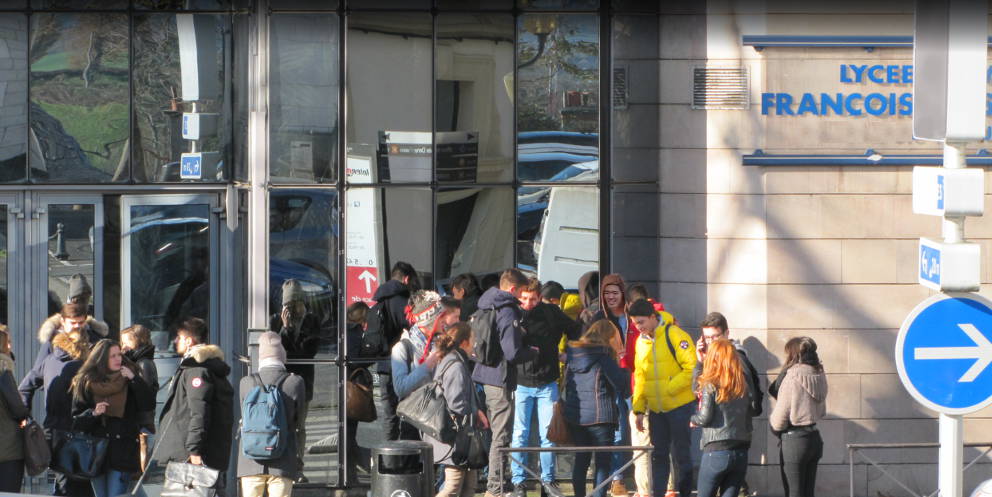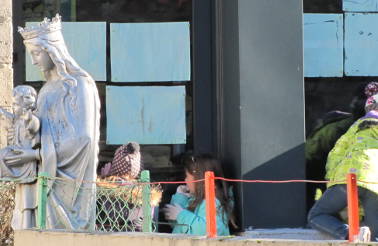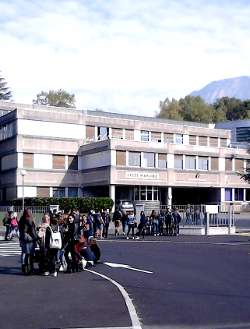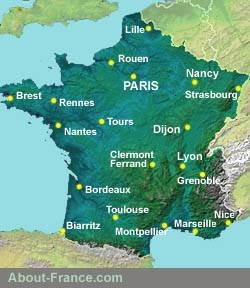
Education in France
Primary and secondary schools in France - from "maternelle" to "lycée"
- Explore France ►
- Essential pages
- Travel in France
- Where to go
- What to see and do
About-France.com
- the connoisseur's guide to France
| Kindergarten | Primary | Middle school |
| Lycée | Public/private | The Baccalauréat |
From kindergarten to high school – Part 1 of a guide to the education system in France
Other
Education pages
- Higher education in France
- Studying in France
- French school holiday dates
- French ministry of education website
Education is compulsory in France from the ages of 6 to 16, but a large majority of children start school well before the minimum age, often as young as two years old, and over 50% of 18-21 year olds in France are still in full-time education, or else following a vocational training course. Some 64% of all school pupils in France complete their secondary education, and take the high-school leaving certificate examinations, known as the baccalauréat or the baccalauréat professionnel. The official target - estimated as necessary for the needs of the nation - is 80%.
No more phones in school...
The French parliament has voted a law to ban mobile phones from primary and middle schools (up to 8th grade) . Exceptions are only made for pupils with special needs, and for classes in which a mobile phone is needed for coursework.The different types of school: (taken by age of pupils):
Ecole Maternelle (kindergarten) and creches ;
Kindergarten or pre-school. Ecoles Maternelles take pupils from age 2 to age 6, and prepare them for entry into primary school. The French école maternelle is more than just a playschool; the curriculum includes reading and writing, numeracy and even sometimes a foreign language, as well as artistic and creative activities. There are three classes, "les petits", "les moyens" and "les grands".Prior to nursery schools, there are also a lot of private and public nurseries, called crèches. These daycare centers keep babies from 2 months to 3 years old, until they can attend the Ecole Maternelle. There ares everal types of crèches (Crèches Collectives, Haltes-Garderies, Micro-Crèches, Crèches Parentales, etc.) providing different services (regular or temporary child care), size (from 10 to 60 children) and management (crèches Parentales require the parents to help). There are more than 11,000 Crèches in France, but getting a slot can be hard, and mothers are advised to look for a slot as soon as they are pregnant. Other alternatives exist, Assitantes Maternelles can keep 3 or 4 babies at their home and are recognized by the French State.
Ecole primaire, or Ecole élémentaire:
Primary school, grade school. Five classes, ages 6 to 11. The primary school curriculum in France is similar to that in other countries, and includes literacy and numeracy, with classes in French, arithmetic, but also geography and history, the arts, and more and more frequently a foreign language, usually English. Until 2008, the school week was Monday to Saturday morning, with Wednesday free. From September 2008, there are no more classes on Saturday morning. Pupils have an average of 28 hours classes per week. The five classes in the Ecole Primaire are, in order, CP, CE1, CE2, CM1, and CM2 : CP is Cours préparatoire, preparatory class, CE means cours élémentaire - elementary class - , and CM is cours moyen, middle class; the two middle classes are a preparation for the next level, which is middle school.Collège:
Middle school. Four levels, normally for pupils aged 11 - 15. The "collège unique" is the backbone of the French school system. All pupils go to collège, usually at age 11, but sometimes at an older age, if they have been made to repeat a year in primary school. The collège is designed to provide all pupils with a fundamental secondary education, after which a certain degree of specialisation will be introduced. In practice, pupils are frequently oriented during their collège years either towards general classes, from which they will be expected to continue their education in a traditional lycée, or towards more technical classes, after which they will be expcted to take an exam called the "brevet" (a kind of GCSE), and then either stop their secondary education (if they have reached school leaving age), or continue in a "lycée professionnel" or vocational high school. The programme in collège includes French, maths, history, geography, technical education, art/music, physical education, civic education, some science, and at least one foreign language. The four classes, corresponding to grades 6 to 9, are called sixième, cinquième, quatrième and troisième.Lycée:
 High
School. The
traditional French lycée covers the last three years of
secondary
education. There are two main types of traditional lycée,
the lycée
général or lycée
classique,
and
the lycée
technique.
In big towns and cities, there will be a mix of both types; in smaller
towns, there may not be a lycée tehnique. The main function
of the
lycée is to prepare pupils to sit the baccalauréat
(or bac) exam, the equivalent of British A levels. Classes in a
traditional lycée cover the same range as in
collège, with the addition
of philosophy (for all) in the final year. The three classes (grades 10
to 12) are known as seconde, première and terminale.
High
School. The
traditional French lycée covers the last three years of
secondary
education. There are two main types of traditional lycée,
the lycée
général or lycée
classique,
and
the lycée
technique.
In big towns and cities, there will be a mix of both types; in smaller
towns, there may not be a lycée tehnique. The main function
of the
lycée is to prepare pupils to sit the baccalauréat
(or bac) exam, the equivalent of British A levels. Classes in a
traditional lycée cover the same range as in
collège, with the addition
of philosophy (for all) in the final year. The three classes (grades 10
to 12) are known as seconde, première and terminale. In theory, all public lycées offer the same quality of education, in the framework of of the national education system, and private lycées have to provide the same quality; in practice, this is not strictly true, and "league tables" published each year highlight the very high performance levels of a number of lycées that are commonly recognised as France's top shools: these include the Lycée Louis-le-Grand or Lycée Henri-IV in Paris, the Lycée Fermat in Toulouse, and a handful of other famous public lycées. However, in recent years, more and more of the top positions in the league tables have been taken by private lycées, such as the Collège Stanislas in Paris, France's largest private lycée.
In 2010, the French lycée league table published by the Figaro newspaper had only 6 state lycées in the top twenty, while that published by the magazine l'Etudiant had only five state lycées among the top twenty, and the league table published by L'Internaute had eight public lycées as against 12 private schools in the top twenty. At secondary school (high school) level, about 20% of pupils are in private schools, against slightly less than 80% in public state school. See below Public and private schools
Pupils in a lycée technique may begin to specialise in a fairly narow technical field, in addition to their general secondary studies. There are technical lycées specialising in fields such as microtechnologies or aeronautics. Technical lycées that provide training in very specialised fields are usually boarding schools, since they recruit pupils from a large catchment area, and even on occasions from all over France.
Lycée professionnel:
Vocational high school. "Lycées Pros", as they are commonly known, provide an essentially non-academic syllabus for young people intending to work in manual or clerical jobs. Pupils will either work towards a "baccalauréat professionnel" (bac pro), for which they will need to continue taking classes in the main acaemic subjects - French, maths, and frequently a foreign language), a BEP (Brevet d'enseignement professionnel), or a CAP (certificat d'aptitude professionnel). One common type of Lycée pro, found in most cities, is the "lycée du bâtiment" or building trades lycée, where pupils specialise in one of the many trades of the building and construction sector. There are also a good number of agricultural high schools, "lycées agricoles" and even horticultural high schools, "lycées horticoles", providing the increasingly technical ducation required by tomorrow's farmers and gardeners.Lycées: les classes préparatoires.
See higher education.Public and private schools in France:
 Most
private schools are run by the Catholic church
Most
private schools are run by the Catholic church
However the private/public divide is not as clear as it is in other countries. Private schools in France are essentially (about 90%) catholic schools, in which there is religious instruction in the curriculum; they select their own teachers, but must follow the same curriculum as state schools if they wish to remain under contract (écoles sous contrat) to the state education system. This is a very important point for almost all private schools, as it means that the state pays the teachers. Consequently, private schools in France only charge symbolic or low fees, and are accessible to pupils from all sectors of society, not just to those whose parents are well-off. There are only a handful of fee-paying boarding schools in France, similar to English "public schools".
The state education system attaches great importance to the principle of secularism (la laïcité), and there is no formal teaching of religion in state schools in France. In theory, religion has no place in state schools in France. However, recent events in France have led to a growing demand for schools to teach religious awareness, this being seen by some as necessary for the development of greater understanding between people of different religions, notably with regard to France's Islamic minority. Religious instruction is not banned from state schools in France; it can take place after hours, for pupils who wish - or at least, that is the legal position. School chaplains (aumoniers) are officially appointed by the "recteur" (Chairperson) of the "académie" (Local Education Authority).
The baccalauréat and grading:
Unlike English "A levels" or Scottish "highers", the baccalaureate is a unitary exam, that pupils pass or fail. It is impossible to pass in one subject and fail in others. The only mark that counts is the final weighted average, which must be at last 10/20 for a pupil to pass. Pupils who achieve just under 10/20 are often passed by the exam board, whose decision is final. Pupils achieving betwen 8 and 10 can resit their bacalaureat as an oral exam a few weeks later. Those who get under 8/20 must retake their year, and try again.The general Baccalaureate is organised in different "series". In their final year, all pupils specialise in function of the "series" they have chosen, of which currently there are three; the "L" series (literary studies), the "ES" series (economic et social studies), and the S" series (sciences). Each "series" includes different specialities. The role of lycées in post-baccalaureat studies is discussed on the higher education page.
There is much discussion among academics and teachers, and in the media, on the question of the "level" of today's baccalaureate. In recent years, the success rate at the Baccalaureat has been betwen 75 an 80% (with top lycées achieving 100%). Many academics complain that the baccalaureate these days is given away, and that this is a major cause of the high failure rate in the first year of university. Ministers and civil servants claim that this is not the case. This polemic, however, is not confined to France, and the arguments over the academic level of high-school leavers is one that is frequently highlighted in the media in many countries, even in Switzerland!
Grading
Grading in the French education system is entirely standardized. All marks or grades for assignments, tests, or exams are out of twenty, and the pass mark is 10/20. This goes from junior school through to postgraduate level.Grade inflation is not as big a problem in France as in some countries, and a mark of over 15/20 remains exceptionally good. However, grade inflation at the Baccalaureate has become an issue since the late 1990s, as figures from the French Ministry of Education show.
The grading system was first set up in for the Baccalaureate in the year 1830, and has not changed in over 170 years - surely a world record! The grades are as follows:
10-11.99
: "passable" or a simple pass.
12-13.99 : "mention assez bien", or a good pass
14-15.99 : "mention bien", or a pass with merit
16 or higher : "mention très bien", or pass with distinction.
Students
getting an average mark of between 8 and 9.99 on their Baccalaureate
exam are entitled to resit the exam a few weeks later. 12-13.99 : "mention assez bien", or a good pass
14-15.99 : "mention bien", or a pass with merit
16 or higher : "mention très bien", or pass with distinction.
Grade distribution and grade inflation
Back in 1967, 68.2% of those who passed the traditional Baccalaureate (Baccalauréat général) were awarded a simple pass. 27.1% got a good pass, and less than 5% got a mark of 14 or more – a pass with merit or distinction.Things remained pretty similar until the mid 1990s, but by 2004 over 14% of successful candidates were getting a mark of 14 or more, and a pass with merit or distinction – three times more than in 1967.
By 2012, over half of all successful candidates got some kind of a "mention" (i.e. a grade of 12/20 or higher), and in 2014 almost 27% of successful candidates got a merit or a distinction (a mark of 14 or higher). 10.7% got the coveted "mention très bien" or Pass with distinction.... up from just 0.3% in 1967.
Still, with only about 1 candidate out of ten achieving the top grade, a top grade at the French Baccalaureate continues to carry a lot of weight – far more so than in countries where the top grade is obtained by up to 30% of candidates. In the UK for instance, 26.3% of A-level grades obtained the equivalent top grade (A or A*) in 2013, and in the USA data suggests that top "A grades" are being awarded to over 40% of students. (There can be no clear comparable national statistics for the USA, as high school graduation is not based on final exams and grading systems or not always the same.)
Education in France, 2: Higher education
About-France.com
Home
page - Site
search
- Regions
- Maps of France
- Contact
The
French education system 1:
Pre-school, primary, secondary
(kindergarten, elementary school, high school)Click
here for part 2:
French
universities and
higher education in FranceYou may
also like
About-France.com's
Online French grammar
A well illustrated and freely accessible grammar for students of French
About-France.com's
Online French grammar
A well illustrated and freely accessible grammar for students of French

A Lycée in the Alps
| ►► French society and culture |
| The regions of France |
| Maps of France |
| France facts and figures |
| The French political system |
| The French economy |
| The French legal system |
| Education in France |
| Health care in France |
| Religion in France |
| The press in France |
| French art |
| Maps
of France
Cities,
towns, departments, regions, climate, wine areas and other themes.
|
| The
French way of
life
A
mine of information about life and living in France, including working
in France, living in France, food and eating, education, shopping.
|
| A-Z dictionary of France Encyclopedic
dictionary of modern France - key figures, institutions, acronyms,
culture, icons, etc.
|
About-France.com
is an independent user-supported website that does not track visitors
and carries very little advertising, Links
to carefully selected affiliate
partner websites may generate commission on sales at no cost
to the
user.

Text
and photos copyright
© About-France.com except
Photo Lycee in the Alps - Creative commons licence
© About-France.com except
Photo Lycee in the Alps - Creative commons licence
